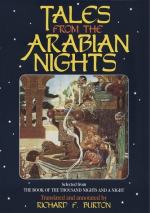[FN#284] The moderns believe most in the dawn-dream.
—Quirinus
Post mediam noctem visus, quum somnia vera.
(Horace
Sat. i. 10, 33,)
[FN#285] The Bresl. Edit. (iii. 223) and Galland have “Torf:” Lane (ii. 115) “El-Tarf.”
[FN#286] Arab. “Maghzal ;” a more favourite comparison is with a tooth pick. Both are used by Nizami and Al-Hariri, the most “elegant” of Arab writers.
[FN#287] These form a Kasidah, Ode or Elegy= rhymed couplets numbering more than thirteen: If shorter it is called a “Ghazal.” I have not thought it necessary to preserve the monorhyme.
[FN#288] Sulayma dim. of Salma= any beautiful woman Rabab = the viol mostly single stringed: Tan’oum=she who is soft and gentle. These fictitious names are for his old flames.
[FN#289] i.e. wine. The distich is highly fanciful and the conceits would hardly occur to a
[FN#290] Arab. “Andam,” a term applied to Brazil-wood (also called “Bakkam”) and to “dragon’s blood,” but not, I think, to tragacanth, the “goat’s thorn,” which does not dye. Andam is often mentioned in The Nights.
[FN#291] The superior merit of the first (explorer, etc.) is a lieu commun with Arabs. So Al-Hariri in Preface quotes his predecessor:—
Justly
of praise the price I pay;
The
praise is his who leads the way.
[FN#292] There were two Lukmans, of whom more in a future page.
[FN#293] This symbolic action is repeatedly mentioned in The Nights.
[FN#294] Arab. “Shakhs"=a person, primarily a dark spot. So “Sawad"=blackness, in Al-Hariri means a group of people who darken the ground by their shade.
[FN#295] The first bath after sickness, I have said, is called “Ghusl al-Sihhah,”—the Washing of Health.
[FN#296] The words “malady” and “disease” are mostly avoided during these dialogues as ill-omened words which may bring on a relapse.
[FN#297] Solomon’s carpet of green silk which carried him and all his host through the air is a Talmudic legend generally accepted in Al-Islam though not countenanced by the Koran. chaps xxvii. When the “gnat’s wing” is mentioned, the reference is to Nimrod who, for boasting that he was lord of all, was tortured during four hundred years by a gnat sent by Allah up his ear or nostril.
[FN#298] The absolute want of morality and filial affection in the chaste young man is supposed to be caused by the violence of his passion, and he would be pardoned because he “loved much.”
[FN#299] I have noticed the geomantic process in my “History of Sindh” (chaps. vii.). It is called “Zarb al-Ram!” (strike the sand, the French say “frapper le sable”) because the rudest form is to make on the ground dots at haphazard, usually in four lines one above the other: these are counted and, if even-numbered, two are taken ( ** ); if odd one (




